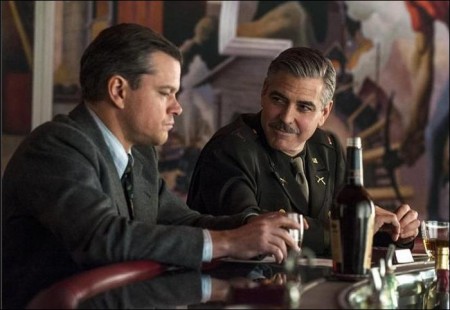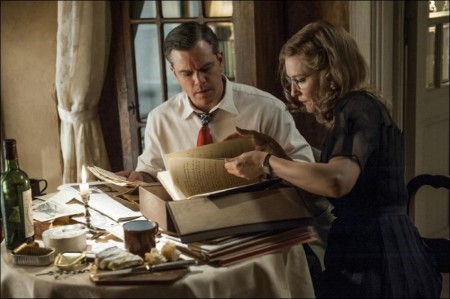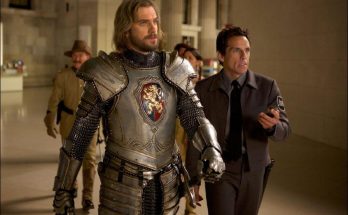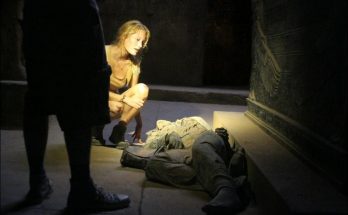An unlikely World War II platoon is tasked by FDR with going into Germany to rescue artistic masterpieces from Nazi thieves and returning them to their rightful owners. It would be an impossible mission: with the art trapped behind enemy lines, and with the German army under orders to destroy everything as the Reich fell, how could these guys – seven museum directors, curators, and art historians, all more familiar with Michelangelo than the M-1 — possibly hope to succeed? But as the Monuments Men, as they were called, found themselves in a race against time to avoid the destruction of 1000 years of culture, they would risk their lives to protect and defend mankind’s greatest achievements.
About the Film
“The story of the Monuments Men is one that really very few people know,” says George Clooney, who returns to the director’s chair for the story of a small group of artists, art historians, architects, and museum curators who would lead the rescue of 1000 years of civilization during World War II in his new film, The Monuments Men. “Artists, art dealers, architects – these were men that were far beyond the age that they were going to be drafted into a war or volunteer. But they took on this adventure, because they had this belief that culture can be destroyed. If they’d failed, it could have meant the loss of six million pieces of art. They weren’t going to let that happen – and the truth of the matter is, they pulled it off.”
The chance to make a World War II movie was extremely attractive to Clooney and his writing and producing partner, Grant Heslov. “There’s a certain romance around these movies – The Great Escape, The Dirty Dozen, The Guns of Navarone, The Bridge on the River Kwai,” says Clooney. “In those movies, you fell in love with the characters and the actors as much as the story. And we thought The Monuments Men was a great chance to cast interesting contemporary actors together for our version of that kind of movie – it’s a fun and entertaining way to do it.”
Part of the drama of the film is that all of the Monuments Men are so unsuited to serving as soldiers in wartime. “Wars are fought by 18-year-olds,” says Clooney. “Once you get to the John Goodmans and the Bob Balabans and the George Clooneys, you know – these guys are not getting drafted.” Heslov adds: “They did it because it was clear that they were the only people who could do it.”
“Actually, we never really fully thought of this as a war film – it was a heist film,” says Clooney. “And then, the first day, we got to the set, and everybody put on their uniforms and helmets.”
Clooney was inspired to tackle The Monuments Men as a feature film not only because of its exciting and dramatic subject matter, but because it marked a sharp, decisive break from his most recent film, The Ides of March. “We were very proud of that film, but it was contemporary, and very small – and also cynical,” says Heslov.
“We’ve made some cynical films, but in general, we really aren’t cynical people,” Clooney continues. “We wanted to do a movie that wasn’t cynical, a movie that was straightforward, old-fashioned, and had a positive forward movement to it.”
In their search for material, Heslov mentioned that he had recently read the book The Monuments Men by Robert M. Edsel with Bret Witter, and brought the subject matter to Clooney. Here was a chance to tell an optimistic story on an epic scale – a true story with huge stakes.
“I was living in Florence, walking across the Pontevecchio Bridge – the only bridge that wasn’t destroyed by the Nazis as they fled in 1944 – and I wondered, this was the greatest conflict in history…how were all of these cultural treasures saved, and who saved them?” Edsel asks. “I wanted to find out the answer.”
The answer was the Monuments, Fine Arts and Archives group, which would go to the front lines and, for the first time, try to save the treasures that could be saved. “Culture was at risk,” says Clooney. “You see it time and time again. You saw it in Iraq – the museums weren’t protected, and you saw how much of their culture was lost because of that.”
“Even today, people are still trying to get back the art that was looted from their families by the Nazis,” Heslov says, noting that just recently, a treasure trove of looted art was discovered in a Munich apartment – 1,500 works worth $1.5 billion, paintings by Matisse, Picasso, Dix, and other artists that had been thought to be lost.
“I think what that goes to show is that this is not a story that ended in 1945 – the search for missing art goes on today,” Heslov continues. “There are still thousands of works that are still lost. There are paintings that are hanging in people’s homes or hidden in plain sight on the walls of museums. Can you imagine if all of that had just been destroyed? It would have been a catastrophe.”
“This story opens up the Second World War in a way that gives you a different perspective on it,” says Cate Blanchett, who plays a key role as Claire Simone, a woman who holds the key to the secret location of thousands of priceless pieces of stolen art.” “These men were spurred on by a higher ideal.” So many of the works that we take for granted in the great museums of the world were returned by this band of men – it was a near impossible task. “Absurd, in a way: non military men going to the front lines and asking generals to stop bombing a certain church or area to save a window, or a sculpture or mural – you wonder how “they were able to save anything at all.” It’s an extraordinary, selfless thing that they did, done to preserve history.”
Though the Monuments Men had the support of FDR and General Eisenhower, they did face a challenge in embedding themselves in the field. “Eisenhower was very keen on the idea – he wanted to make sure that there was something left when the war was over – and the war was going to be over very soon,” says Clooney. “It was something he came to, after Allied bombing destroyed an ancient abbey that really didn’t need to be destroyed. So it was important not just to protect the art from the Nazis, but from the Allies’ own exploits as they pushed toward the end of the war. The Allies were blowing everything up, so they had this realization that culture can be destroyed – not just by the Germans, but by us.”
Edsel says that many museum directors in the US had concerns about the art and cultural treasures that could be lost in the war, but that they were working at cross purposes – each director with his own plan – rather than in concert. “George Stout – who would later become the unofficial leader of the Monuments Men – made some efforts, but he gave up on it – he figured no one was going to approve the idea of a bunch of middle aged art historians, architects, and artists running around with combat soldiers.” But then Roosevelt approved the idea – and not a moment too soon. “In August 1943, the Allies nearly destroyed The Last Supper inadvertently,” Edsel continues. “I think that set off the alarm bells and accelerated getting the monuments officers into the field.”
Edsel says that one might expect that soldiers fighting a war would not be receptive to being told what they could and could not blow up – but it’s just the opposite. “Much to their surprise – and we found this in their letters home, over and over again – there was only mild resistance at the beginning, and that quickly gave way to soldiers asking, ‘How are we doing? Have we saved any churches? Have we found any paintings?’ The military started getting pretty engaged.”
The Monuments Men were also working against a ticking clock. As the Allies closed in on Berlin, Hitler was unwilling to accept unconditional surrender – and if he couldn’t have Germany, no one else would either. “It became known as the ‘Nero Decree,’ Clooney explains. “Hitler said, ‘If I die, destroy everything’ – bridges, railroad tracks, communications equipment – and that was taken to mean the art, too. Everything.”
The Monuments Men
Directed by: George Clooney
Starring: George Clooney, Daniel Craig, Bill Murray, Cate Blanchett, Jean Dujardin, Matt Damon, John Goodman
Screenplay by: George Clooney, Grant Heslov, Robert M. Edsel
Production Design by: James D. Bissell
Cinematography by: Phedon Papamichael
Film Editing by: Stephen Mirrione
Costume Design by: Louise Frogley
Set Decoration by: Bernhard Henrich
Music by: Alexandre Desplat
MPAA Rating: PG-13 for some images of war violence and historical smoking.
Studio: Sony Pictures, 20th Century Fox
Release Date: February 7, 2014
Visits: 50





